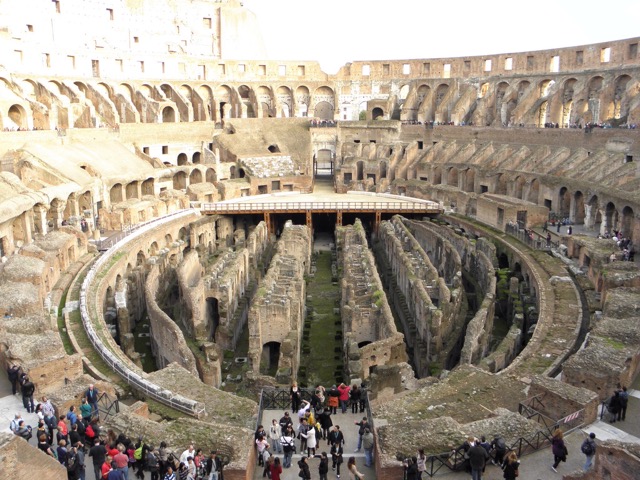Anyone visiting Rome, Italy takes a step back in time and makes a connection with ancient history. The Colosseum is a very popular attraction for tourists.
Construction began around 70 A.D. commissioned by Emperor Vespasian of the Flavian Dynasty. When completed and opened in 80 A.D., this massive stone arena was known as the Flavian Amphitheater. With construction technology available to them 2000 years ago, it is an engineering marvel of Roman builders. Upon completion, the four main floors reached a height of 157 feet. Measuring 620 by 513 feet, the outside perimeter is 1788 feet. The central arena is 180 feet wide and 287 feet long. Below the central arena is a series of tunnels and rooms that housed gladiators and wild animals. Hand operated elevators raised gladiators and wild animals to the arena floor. Capacity of the Colosseum was estimated to be between 50,000 and 75,000 spectators.
In the central arena, celebrations, wild animal fights and games, some brutal, were held for the enjoyment of Roman citizens. Here gladiators consisting of slaves, prisoners-of-war, and condemned criminals would fight to the death. For over four centuries, this arena entertained Roman citizens. The games were held until the 6th Century. Then this magnificent structure fell into neglect with the fall of the Roman Empire.
Over the centuries, it was used as a source of building materials, much of it marble, for other structures including St. Peter Basilica, St John Lateran, Palazzo Venezia, and defense fortifications along the Tiber River. Adding to the deterioration, earthquakes, lightening and vandalism caused two-thirds of the Colosseum to be destroyed. One earthquake collapsed the entire outer south wall. In the 18th Century, various popes sought to conserve the Colosseum as a Christian site although it is mere speculation Christians were martyred there. Beginning in the 1990’s, aggressive restoration programs commenced to conserve this important ancient structure for history and posterity.
As tourists enter what is now left of this historic structure and they touch the bricks, mortar and carved columns, they must have a feeling of reaching back 2000 years and making a connection with the builder who placed them there and wonder who he was.
Pilgrimage to Italy 2012


